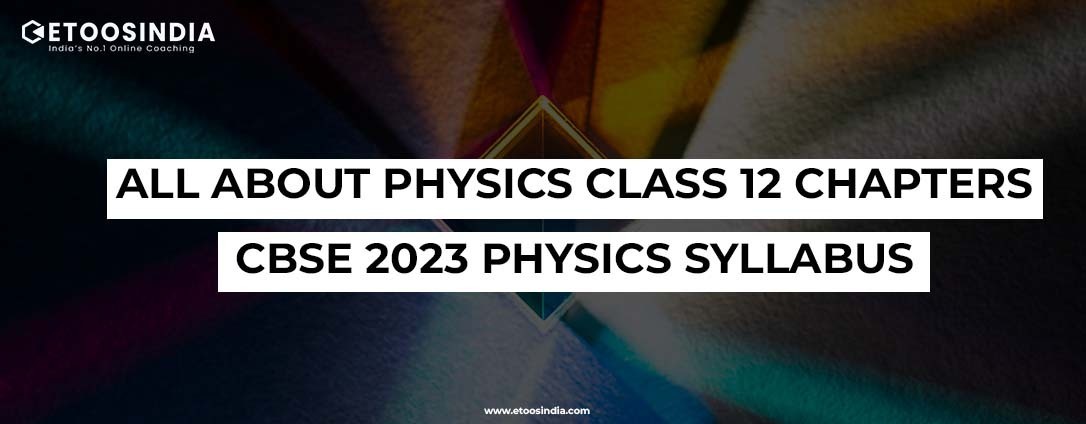All About Physics Class 12 Chapters - CBSE 2023 Physics Syllabus

Physics forms a major part of the CBSE class 12th syllabus in science. Being the most fundamental unit of science it helps us in understanding the world around us. Thus to score well in the CBSE class 12th boards Physics it is important to have a thorough knowledge of the Physics class 12 chapters. The CBSE board exams are of prime importance in deciding your college and thus these exams cannot be taken for granted. Therefore each subject should be given precise attention.
The Physics class 12 chapters includes nine chapters and hence it is advised that the students should have deep knowledge of the same. So, here is a detailed chapter-wise analysis of topics and their weightage.
CBSE Physics class 12 chapters
The central board of secondary education is the administering authority of the class 12th boards. It is this body that is responsible for forming the CBSE class 12th boards syllabus and thus it is the same body that forms the Physics syllabus too. As per the latest update from the board, no new chapters have been added and no chapters have been exempted from the Physics class 12 chapters.
Getting familiar with the syllabus is important to plan your preparation. Along with chapters, you should acquaint yourself with the marking scheme this will help you know how much time should be allotted to each topic.
CBSE Physics class 12 chapters: Units along with weightage
As mentioned the Physics class 12 chapters incorporate 9 units that have been mentioned with topics in the table below:
|
Unit No. |
Name of Unit |
No. of Periods |
Marks |
|
Unit–I |
26 |
16 |
|
|
Chapter–1: Electric Charges and Fields |
|||
|
Chapter–2: Electrostatic Potential and Capacitance |
|||
|
Unit-II |
18 |
||
|
Chapter–3: Current Electricity |
|||
|
Unit-III |
25 |
17 |
|
|
Chapter–4: Moving Charges and Magnetism |
|||
|
Chapter–5: Magnetism and Matter |
|||
|
Unit-IV |
Electromagnetic Induction and Alternating Currents |
24 |
|
|
Chapter–6: Electromagnetic Induction |
|||
|
Chapter–7: Alternating Current |
|||
|
Unit–V |
04 |
18 |
|
|
Chapter–8: Electromagnetic Waves |
|||
|
Unit–VI |
30 |
||
|
Chapter–9: Ray Optics and Optical Instruments |
|||
|
Chapter–10: Wave Optics |
|||
|
Unit–VII |
Dual Nature of Radiation and Matter |
08 |
12 |
|
Chapter–11: Dual Nature of Radiation and Matter |
|||
|
Unit–VIII |
Atoms and Nuclei |
15 |
|
|
Chapter–12: Atoms |
|||
|
Chapter–13: Nuclei |
|||
|
Unit–IX |
Electronic Devices |
10 |
07 |
|
Chapter–14: Semiconductor Electronics: Materials, Devices, and Simple Circuits |
|||
|
Total |
160 |
70 |
Here is a detailed analysis of Physics class 12 chapters
Unit-1 Electrostatics
Chapter–1: Electric Charges and Fields
This chapter includes Electric charges, Conservation of charge, Coulomb's law-force between two point charges, forces between multiple charges; superposition principle and continuous charge distribution.
Electric field, electric field lines, electric dipole, electric field due to a point charge, electric field due to a dipole, torque on a dipole in the uniform electric field.
Electric flux uniformly charged infinite plane sheet and uniformly charged thin spherical shell, statement of Gauss's theorem and its applications to find field due to infinitely long straight wire.
Also Read: Tips to prepare for JEE main physics question paper
Chapter–2: Electrostatic Potential and Capacitance
equipotential surfaces, the electrical potential energy of a system of two point charges and of electric dipole in an electrostatic field. Electric potential, potential difference, electric potential due to a point charge, a dipole, and a system of charges.
Dielectrics and electric polarization, capacitors, and capacitance, a combination of capacitors in series and in parallel, the capacitance of a parallel plate capacitor with and without dielectric medium between the plates, energy stored in a capacitor, Conductors and insulators, free charges and bound charges inside a conductor.
Also Read: Important chapters for JEE exam by NTA
Unit-2 current electricity
Chapter–3: Current Electricity
Electric current, the flow of electric charges in a metallic conductor, drift velocity, V-I characteristics, electrical energy and power, electrical resistivity and conductivity, the temperature dependence of resistance, emf of a cell, combination of cells in series and in parallel, Kirchhoff's rules, Wheatstone bridge. mobility and their relation with electric current; Ohm's law, Internal resistance of a cell, potential difference and emf of a cell, the combination of cells in series.
Unit-3 Magnetic Effects of Current and Magnetism
Chapter–4: Moving Charges and Magnetism
Oersted's experiment, Concept of the magnetic field.
Biot - Savart law and its application to the current carrying circular loop.
Straight solenoid, Ampere's law, and its applications to an infinitely long straight wire, force on a moving charge in uniform magnetic and electric fields.
The forces between two parallel current-carrying conductors-definition of an ampere, Force on a current-carrying conductor in a uniform magnetic field, torque experienced by a current loop in a uniform magnetic field; Current loop as a magnetic dipole and its magnetic dipole moment, conversion to ammeter and voltmeter and moving coil galvanometers current sensitivity.
Also Read: CBSE passing marks criteria 2023
Chapter–5: Magnetism and Matter
Bar magnet, bar magnet as an equivalent solenoid magnetic field intensity due to a magnetic dipole along its axis and perpendicular to its axis, torque on a magnetic dipole, in a uniform magnetic field, magnetic field lines.
Magnetic properties of materials- Para-, dia- and ferromagnetic substances with examples, Magnetization of materials, the effect of temperature on magnetic properties.
Unit-4 Electromagnetic Induction and Alternating Currents
Chapter–6: Electromagnetic Induction;
Electromagnetic induction; Faraday's laws, induced EMF and current; Lenz's Law, Self, and mutual induction.
Also Read: Difference Between online and offline test series
Chapter–7: Alternating Current
Alternating currents, peak and RMS value of alternating current/voltage; reactance and impedance; LCR series circuit (phasors only), resonance, power in AC circuits, power factor, wattless current. AC generator, Transformer.
Unit -5 Electromagnetic waves;
Chapter;8: Electromagnetic Waves
Basic idea of displacement current, Electromagnetic waves, their characteristics, and their transverse nature (qualitative idea only).
Electromagnetic spectrum (radio waves, microwaves, infrared, visible, ultraviolet, X-rays, gamma rays) including elementary facts about their uses.
Unit-6 Optics
Chapter–9: Ray Optics and Optical Instruments
Ray Optics: Reflection of light, spherical mirrors, mirror formula, refraction of light, total internal reflection and optical fibers, refraction at spherical surfaces, lenses, thin lens formula, lens maker’s formula, magnification, power of a lens, a combination of thin lenses in contact, refraction of light through a prism.
Optical instruments: Microscopes and astronomical telescopes (reflecting and refracting) and their magnifying powers.
Also Read: Career Options after 12th science
Chapter–10: Wave Optics
Wave Optics: Wavefront and Huygens principle, reflection and refraction of plane waves at a plane surface using wave fronts. Proof of laws of reflection and refraction using Huygens principle. Interference, Young's double slit experiment and expression for fringe width (No derivation final expression only), coherent sources and sustained interference of light, diffraction due to a single slit, and width of central maxima (qualitative treatment only).
Unit-7 Dual Nature of Radiation and Matter
Chapter–11: Dual Nature of Radiation and Matter
Dual nature of radiation, Photoelectric effect, Hertz and Lenard's observations; Einstein's photoelectric equation-particle nature of light. Experimental study of photoelectric effect Matter waves-wave nature of particles, de-Broglie relation.
Unit-8 Atoms and Nuclei
Chapter–12: Atoms
Alpha-particle scattering experiment; Rutherford's model of atom; Bohr model of the hydrogen atom, Expression for the radius of the nth possible orbit, velocity and energy of the electron in his orbit, of hydrogen line spectra (qualitative treatment only).
Also Read: CBSE Board exam 2023
Chapter–13: Nuclei
Composition and size of nucleus, nuclear force Mass-energy relation, mass defect; binding energy per nucleon and its variation with mass number; nuclear fission, nuclear fusion.
Unit-9 Electronic Devices
Chapter–14: Semiconductor Electronics: Materials, Devices and Simple Circuits
Energy bands in conductors, semiconductors and insulators (qualitative ideas only) Intrinsic and extrinsic semiconductors- p and n-type, p-n junction Semiconductor diode - I-V characteristics in forward and reverse bias, application of junction diode -diode as a rectifier.
FAQs
What are some tips and tricks that you have learned from your seniors about how to crack the Joint Entrance Examination (JEE) Mains?
To crack the JEE 2023 exam you need to adopt the best ways to prepare for IIT-JEE. Given are some of the tips that will help you breeze through the exam with flying colors:
-
Get acquainted with the JEE 2023 syllabus
-
Familiarize yourself with the JEE exam pattern
-
Form a JEE 2023 preparation study plan
What are some great mistakes that every student makes during IIT JEE preparation?
The JEE aspirants should avoid the given mistakes during IIT JEE preparation to excel in the JEE exam:
Given the mistakes that you should avoid:
-
Avoid studying from too many reference books
-
Do not skip NCERTs
-
Do not leave important topics for the last minute
How do I apply for the JEE Main 2023?
Follow the given instructions to apply for the JEE Main 2023:
-
Login to the official website of NTA
-
Click the link to apply for JEE Main 2023
-
Read the instructions and click proceed to apply online
-
Fill in the Name, D.O.B, Nationality, State, type of ID and its details (A government approved id), address, mode of examination, exam center, exam medium, mailed, and contact number
-
Fill academic details
-
Fill in the guardian details
-
Create the password and submit it
Keep following EtoosIndia CBSE Articles for the latest updates.

 9214233303 /
9214233303 / 






